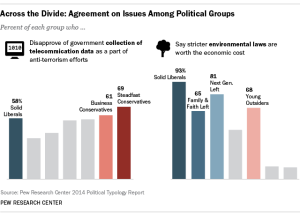

The Pew Research Center has been doing its Political Typology reports every few years since the first one in 1987. The typology study published today is a follow-up to our report on political polarization in America and draws on the sample of 10,013 adults nationwide surveyed earlier this year. We asked Scott Keeter, Director of Survey Research, to explain why — and how — we do this particular analysis.
Why did you create the political typology?
The goal of the political typology is to sort people into homogeneous groups, based on their political values and attitudes. It’s an effort to categorize people politically to help us better understand the complexities of the current political landscape. This kind of “clustering” gives us a way to quickly summarize a large amount of complex information, to understand differences among people, and to help predict how people are going to act in the future.
The urge to categorize is so strong that it is almost a part of being human. People have long tried to classify the things they deal with in life, whether we’re talking about animals, vegetables, minerals, diseases, songs, celestial objects – but we especially like to classify humans.
Isn’t the distinction between Democrats and Republicans all we need?
Political parties are one kind of grouping of like-minded people. But parties – at least in the U.S. – tend to be large agglomerations, with schisms and factions. Moreover, a growing number of people do not think of themselves in partisan terms, though they still have strong political views. Groups in the political typology may have a recognizable partisan tilt, but they are more internally consistent than the major U.S. parties. Understanding this pattern may help us understand the tensions in the two-party system and where there are political agreements or disagreements that are masked by the partisan lens through which most politics is viewed.
Do the groups in the political typology correspond to real-world groups?
There is considerable overlap between the most ideologically distinct groups in the typology and the two major political parties: 86% of Steadfast Conservatives and 84% of Business Conservatives think of themselves as Republicans or lean Republican, and 89% of Solid Liberals think of themselves as Democrats or lean Democratic. But many of the groups who occupy the middle of the political spectrum contain a mix of Republicans and Democrats, and don’t necessarily correspond to organized groups in the political world. One reason for this is that politics is a peripheral concern for most people, especially for people who hold a mix of liberal and conservative views. The lack of interest in politics, as well as a sense of futility regarding the ability to influence political decisions, reduces the incentive to organize and act, even when a relatively large number of people may have similar political views. But this can be a vicious cycle – people who feel they are “outside” of the red vs. blue debate may feel that nobody shares their views. The typology shows that that is not the case.
How do you find the groups in your data?
If we were trying to group people on the basis of only two or three issues or values, it would be relatively easy. But the complexity increases as the number of attitudes and values we want to consider increases. And so we use a statistical technique to identify groups of people who hold similar values and opinions across a large set of questions asked in the survey – 23 in the current typology – each of which gets equal weight in the process. This technique is called “cluster analysis.” Given the complexity of the data, it’s possible to sort respondents into many different combinations, depending on how large and how homogeneous we want the groups to be. Unlike many other statistical techniques, cluster analysis does not produce a single “correct” result. Instead, we run numerous versions of it (e.g., asking it to produce different numbers of clusters) and judge each result by how analytically practical and substantively meaningful it is. Fortunately, nearly every version we produced had a great deal in common with the others, giving us confidence that the pattern of divisions we found were genuine.
Does this typology differ from prior ones? Has the ideological makeup of the U.S. public really changed that much, or are the criteria different, or is there some other reason?
There’s actually more continuity than change in the typology when you look back over the past 27 years. We’ve nearly always found two strongly conservative groups that are divided over social issues. Similarly, we have usually found a group of across-the-board liberals at the other end of the spectrum. In the middle, a group of financially hard-pressed and sometimes disaffected individuals usually emerges, along with one or two younger, more upbeat groups.
Most of the questions that went into this year’s typology are the same as in the past. But not everything is the same. We added a few items to reflect the fact that the political agenda has changed somewhat over time. These include questions on marriage and family, the fairness of the economic system, personal privacy vs. protection from terrorism, and the importance of U.S. involvement in international affairs.
Two other changes were made in the statistical analysis. One is that we used individual survey measures rather than scales as inputs to the typology. Another is that we omitted measures of party affiliation and financial stress, which were used in previous typologies.
You are missing my political group. Why is that?
If your group is distinctive because of issues and values other than the ones we asked about, we probably couldn’t find you. Similarly, if your group is smaller than our average group (between 10%-15% of the general public), you wouldn’t have been discovered by our method.
One group that many people have asked about are libertarians. We actually devoted a great deal of effort in trying to identify libertarians, and in an upcoming report we will discuss this effort and describe how libertarians fit into the typology. The shorter answer is that many members of the Business Conservative group would qualify as libertarian, if by libertarian we mean a preference for minimal government involvement in economic and personal affairs. But unlike many libertarians, most Business Conservatives favor the use of overwhelming force against terrorism, think the U.S. should be active in world affairs and believe that military strength is the best way to achieve peace. Similarly, a plurality of Business Conservatives opposes allowing gays and lesbians to marry legally. For these and other reasons, we decided not to describe this group as libertarian. Similarly, it’s likely that there are libertarians among the Young Outsider group, who are socially liberal and fiscally conservative. But many of them favor regulation to protect the environment, and thus don’t fit easily into the libertarian category.
